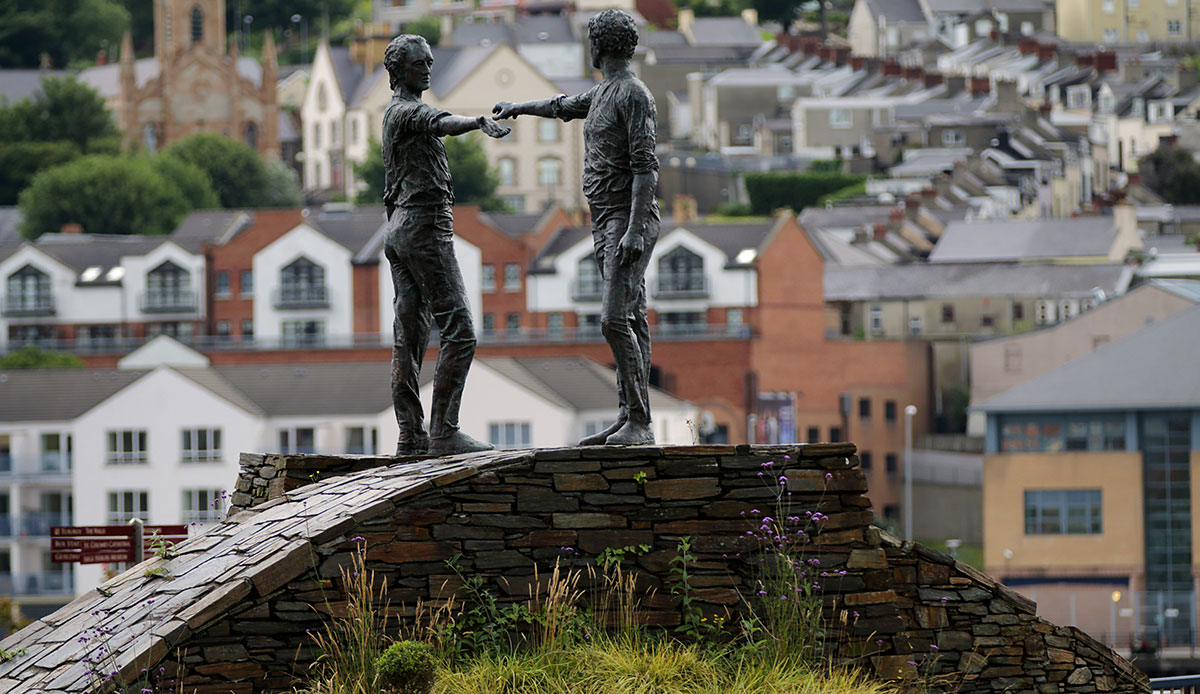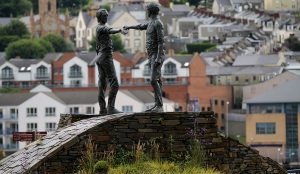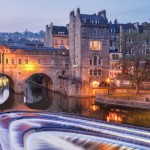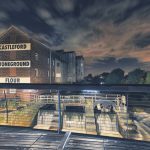
Five Minutes Spare goes to Londonderry & Yes! Derry and Londonderry are the same place!
Asides from settling that long-pondered question, we wanted to take a traditional Five Minutes Spare look at this fabled Irish treasure. This city is one of the five biggest cities in the whole island and takes its name from the humble Oak Grove. There aren’t so many oaks nowadays – but there are a hundred other sights you should see.
Let’s jump into the exciting history of Londonderry… and find out where they got the London part of their name from…
Early Derry Days
To answer our own question, the London suffix was added by King James I all the way back in the 17th century. Before that, it was known as Derry, a derivative of Irish for ‘Oak Grove’. Say Doire a few hundred times with an Irish accent and you see where the name came from.
Derry is considered one of the oldest settlements in Ireland. Its situation on the river and in the inside of a bay allowed for easy trading and plentiful crops. The earliest mention of Derry in the history books is in the 6th century, when we know there was a monastery built by St. Columba. There are legends and songs that place the lands in his hands at the will of an old Irish King. The monastery remained until the 11th century. During this time, Derry was known as a religious centre and a mostly monastic place.
Towards the end of this time period there would have been Vikings raiding up and down the coast. Luckily, the monastery escaped most of the raids. In the 12th and 13th centuries the area saw Norman colonists move in. The Normans invaded England in the 11th century so it makes sense that they might continue west. By the 14th century a Norman Earl had been appointed as Earl of Ulster. His name was Richard de Burgh, who bought the lands from the Bishop.
There were (at least) two Richard de Burgh’s who were Earls of Ulster back then, but the latter one was the one responsible for buying Derry from the church. The Earldom of Ulster didn’t progress beyond the 14th century. Not a hundred years of peaceful settlement and Norman mingling later, and the English arrived. The first ships landed in 1566, later bringing an expeditionary force in 1568. This force desecrated a church, successfully garrisoned the town for a while, and then brought colonists over. The sight of the desecrated church is where the Long Tower Church now stands.
In 1600 the Nine Years War broke out as a result of all the desecration and the English held Derry for three years. By 1608 Tyrone’s Rebellion had been mostly put down. The city was attacked, the Earls fled, and the new King in England was most unhappy. He renamed the Ulster city as Londonderry, sent Scots and English folk over, and turned it into a largely protestant community.
To this day, some people don’t like the dropped ‘London’ of the title, and some folk insist upon it. Realistically, it is an argument unlikely to ever be settled.
Londonderry in Medieval Times
In the 17th century, the Ulster Plantation was planned out and several new buildings were added. The Cathedral was one of the first, dating to 1633. This Cathedral was the first of its kind anywhere in the world. What was so different about it? It was built just after the Reformation of the church caused by Henry VIII when he wanted to get divorced… among other things. This was the first protestant cathedral in the known world.
In 1680 the city contained an estimated 2k people, which admittedly wasn’t great. Fortunately, the only way was up, and the industrial revolution hadn’t hit yet. The city was repeatedly attacked by the – err – other Irish, for about ten years. There were those that wanted to protest English rule… a situation that much of the world has experienced at some point.
When possible-king Charles was fleeing north, Derry was under siege from the ‘true’ Irish. Inside the city walls, the British were arguing about who supported the king and who supported the not-king. It must have been a time when everyone was scared to breathe in case they got a spear to the throat.
It gets worse, because the city was then laid siege from the Scots and their Presbyterians, led by actual King Charles I. Irish generals were having none of it, they temporarily came together to evict those crazy Scots and then- then they all started fighting again. Forgive us if we are getting confused.
We think this is the perfect time to stop for some fun facts. Things are getting a little murder-y for our taste.
Fun Facts About Londonderry
There are loads of interesting and fun facts to have come from this city. We picked out some of the Five Minutes Spare favourites for your amusement.
- The Derry city walls were built in the 17th century so we will cover them soon. They are known to be the most complete set of walls in Europe. When cities were walled for protection they would often expand beyond those boundaries, which would be lost. Not so in Derry.
- When America first became a destination (back in the industrial age) and people flocked to ports to catch ships, many used Derry as their port of choice. During the world wars, Derry played host to 19 different German U-boats captured in their waters. Well done Derry, that’s a hefty contribution to the war effort!
- There have been two Nobel Prize winners from the same educational establishment in Derry. Seamus Heaney (literature) and John Hume (peace) both studied at St. Columb’s College[i]. What an achievement!
- The Siege of Londonderry began on 20th 1689 and lasted for 105 days. The Battle of the Boyne finally finished it. More on that in a moment.
Derry has a variety of rich and interesting historical stories for you to choose from. Unfortunately, most of them involve epic and bloody battles. Let’s pick the history back up again and learn about a few.
The 17th Century Onwards
1689 saw James II, the catholic kind, deposed by Mary and William of Orange. James fled to France, found no help, and landed in Ireland to ask them. He then invaded Dublin, took it, and marched on north to Derry with the intention of finishing off support for his daughter. He surrounded the city for 105 days but, in spite of having no supplies, poor weapons and armour, and only 1,200 troops: the people of Derry managed to beat off repeated attacks from his men. After the 105 days, a British garrison arrived to relieve them. That’s some inspiring stuff.
James was finally defeated 11 months later at the Battle of the Boyne. Unfortunately, the man who had coordinated defence of the city died in that same battle. We think he would have been happy with the outcome of the fight, nevertheless.
In the 18th century a bridge was finally built across the River Foyle. George Berkeley was in the seat as Dean of Derry. After this, the industrial revolution brought extensive rebuilding of parts of the city. Many migrants left the port for a better life in America during this time period. 1845 through 1851 saw the potato famine… which we feel needs a little explaining.
The potato became a staple of the Irish because they are so highly nutritious that a family could live on them, using only a handful of acres of land. Ireland was thriving with this super-crop. The population went from around 2 million to over 8 million in the century previous to the great famine. When it struck, it is estimated that about 1.5 million of those fled to America. A further 1.5 million died through lack of food. A significant portion of the population were starving, and the suppliers of grain and corn raised their prices in response.
This was one of the worst periods of history in any of the developed countries. It would have been a horrendous time to be alive. People dropped dead in the street and there was nobody strong enough to take away the bodies. Diseases were rife because nobody had an immune system… Derry suffered thorough this period. It became the port from which you left the country for better lands. The reality being that most would die on the ships of starvation before they ever made it.
What we do know is that Derry got off reasonably lightly. It is estimated that the population of Ulster fell by 15.7%. Horrific – but the national average per county was 19.9%. Irish people are sick of hearing about this and study it extensively in school, but the rest of the developed world would do well to read some of the accounts of the time. It’s grim, but it doesn’t bear repeating.
A Little More Modern…
Cut to the 19th/20th centuries and the city had a huge textile industry with shirts and collars at the centre of the fold. 4 different railways actually emanated out of Derry. As a Port city, it was an important trading point for everyone in the north. It supplied fine cloth and shirts in return. In 1880 the Magee College became the Royal University of Ireland, and the first university in Derry.
As we already mentioned, Londonderry contributed hugely to the war effort. The navy were stationed at the port and used it to launch from, and as a base for captured vessels. They had a big influence in the Battle of the Atlantic, providing the ships and soldiers, as well as supplies.
Unfortunately, Derry has had a turbulent time of it in the 20th century. The 1920’s saw it turned into a border city. The Irish Wars of Independence then saw the city up to its neck in violence. There were riots, and murders, and the ones that suffered most were the civilians. After a full week of political violence the army sorted it out.
In the 60’s more troubles saw the unionists and nationalists clash. Some want independence, some don’t. It is a recurring theme in countries that have a point of control outside of their own politic power centre. In ’72 the flames were stoked by British paratroopers shooting unarmed civilians. Another 13 people later died as a result of this incident. You might have heard of it before? It is known internationally as ‘Bloody Sunday’. It’s enough to bring tears to your eyes.
Since then there have been countless murders, riots, and even bombings. The IRA and the British army spent much of the 80’s fighting each other – and yet the story is so much more than that. Londonderry gained international attention throughout ‘the Troubles’ and right up until the 90’s, when things calmed down a little. Since then, it has become a thriving port town that people of the north go to for staycations.
We hope it continues to be peaceful and prosperous for the next few hundred years. Wouldn’t it be something if we lived to see the end of any fighting in our lifetime? That goes for all countries, but especially for Derry. It seems like fighting has been part of Irish history forever already.
Let’s put the horrible histories behind us though. There have been plenty of famous faces borne from Londonderry. Let’s pick out the best of them…
Famous People from Londonderry
Some of the Five Minutes Spare favourite famous folk to come from Derry include:
- Most of the ‘Derry Girls’ cast, unsurprisingly, are from Derry or its surrounds. If you haven’t watched it yet you are missing out!
- Michelle Fairley, that’s Catelyn Stark from Game of Thrones to you and me, is a Derry girl herself.
- 3 residents have received the Victoria Cross: Edward Leach, John Park, and Miles Ryan. May they never be forgotten.
- Nadine Coyle, of Girls Aloud, is Derry born.
- Neil Hannon lead singer of the Divine Comedy, as well as most of the band ‘The Undertones’ are from Derry.
- A third winner of the Nobel Prize is from Derry. He won the 2015 Physiology or Medicine prize for his work in biology and parasitology.
We feel we should stop there in case other towns get jealous. The list is long though, and we never even got to sports. You can have a gander here, if you are interested.
Derry Attractions

Image: Bildagentur Zoonar GmbH/Shutterstock.com
Finally! The section you have all been waiting for! What are the best things to see and do in Londonderry? We found out…
Historical Sights and Landmarks
Let’s start with some of the awesome history of the town. The Walls of Derry are one of the best starting places. Take a tour or enjoy a hike around the intact city walls – knowing they are some of the lengthiest in Europe. Something we forgot to mention earlier is that Derry has a strong connection with Amelia Earhart. She landed her plane in the fields outside of town after being the first woman to ever complete a transatlantic crossing. There is a museum in town in her honour… but you can follow the story here.
If you want Instagram worthy photographs of picturesque buildings then you need either the old Guildhall or St. Columb’s Cathedral. You might also spot St. Augustine’s Church spire on the skyline. All three are ideal for an ‘I went to Derry’ postcard worthy pic.
Museums and Galleries
Like any other city it has its fair share of museums and galleries to showcase Irish artists – which are plentiful. Visit the Tower Museum. This place tells you all about local history and is thus named because it is a tower. It’s a great place for those that want to muddle out the history.
There are 3 other museums we could recommend in the city of Derry. Stop in and see the Siege Museum for details about the 105 days they defended the town for, away back when. See the Bloody Sunday Centre for a macabre documentation of events that should never be forgotten. You can also learn about the maritime history of the town at the harbour museum. Since this place was the confluence of four separate railway lines we also recommend you check out the Foyle Valley Railway Museum.
Outdoor and Recreation
If you fancy a walk on a pleasant summer day, or perhaps a picnic with the kiddies, visit either Brooke Park or St. Columb’s Park. Brooke park has a leisure centre located in it so you can go to the gym, in the park, which is nicer than a town centre gym. St. Columb’s has a stately home in the centre of it, waterways, a bit of river, and some gorgeous woodlands.
The River Foyle flows through town and is a favourite among locals, with the Peace Bridge being a central attraction. This sculpted bridge can be seen from all over the city and is only accessible by foot. You can also learn about the best beaches in the County, here.
Shopping and Retail
The Craft Village is an absolute must and ties in to the lack of galleries in town. You can find all the things an artist desire here. It’s quaint, it’s cute, and it’s the reason Ireland is chock full of creative talent… at least in Derry.
Other shopping options include the Richmond Shopping Centre, The Foyleside Shopping Centre, and the Quayside centre. To be honest, we haven’t even scratched the surface. Port towns always tend to have the best retail establishments.
Football!
Lastly for our section on attractions, we couldn’t get this far without mentioning the football club. The Derry City team play in Brandywell Stadium. Fans can book the stadium tour or go and watch them practice. The City of Derry RFC are a formidable team in the world of Rugby, as well. You can find them at the Craig Thompson Stadium, which is immense in size.
Other Notable Attractions
There are so many things to do in Derry that we couldn’t possibly squeeze them all into one article – but dash it we tried! Here are a few more things to do in Derry that didn’t quite make the cut:
- The Republican Murals and a sight worth visiting regardless of where you fall in the situation. There are a number of them, with the Girl in School Uniform being a firm favourite.
- Free Derry corner, there is a painted house that marks where you are entering Free Derry as opposed to Londonderry. This marks a clear divide between unionists and those that would be independent from British rule. We don’t want to get political, but everyone should see it, regardless of inclination. It’s an iconic display known throughout the world.
- The Apprentice Boys Memorial Hall is a gorgeous old building worthy of Snaps.
- St Eugene’s Cathedral is a stunning sight.
- The Ness Wood is a great place for visitors to the city to enjoy the greener areas of town.
So if you do go to Derry for a visit or a vacation, you can be sure to find things to suit you.
How to get There?
We have covered just about everything there is to know about Derry – except we haven’t told you how to get there, yet.
By Road
You head north west from Belfast. If you follow the coast north and around, you will eventually reach it.
By Rail
Londonderry Train Station is a known centre of activity for different train lines.
By Air
Londonderry airport is about 7 miles from the centre of town. It is better known as the City of Derry Airport.
By Sea
Aim for the port of Derry. If you head for the north east of Ireland, you can’t lose.
Have Five Minutes Free?
We cover all sorts of travel itineraries to all sorts of places. We can also help you learn about the law or find yourself a new hobby. Everything is possible over at Five Minutes Spare HQ… all you need to bring is yourself. Maybe we will see you there?
[i] https://www.myinterestingfacts.com/derry-facts/





